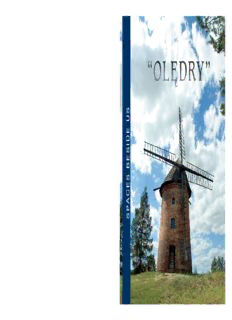
katalog-olendry ANG 01.p65 PDF
Preview katalog-olendry ANG 01.p65
S U E D I S E B S E C A P S MUZEUM NARODOWE W POZNANIU ISBN 978-83-89053-55-8 MUZEUM NARODOWE W POZNANIU 2 3 PPPPPrrrrreeeeefffffaaaaaccccceeeee The poster by Mirosław Adamczyk, an invitation to the exhibition, fosters the memory of something that recedes into the past – the windmill, rooted in the ground, with its outstretched heaven-bound arms, the simple embroidery on a small wall hang- ing. Once hallmarks of the landscape and household items, part and parcel of inhabited space, they withdraw to special places, i.e. museums like ours. They are moved to places appointed by communities for preserving a memory of the possible ways of making this earth habitable. They talk volumes by means of objects, evidence of taming this world, tools for claiming land, building homesteads, performing the simplest chores and the activities sanctioned by community custom, tools used for decoration, cele- bration, and deriving joy from the transformation of matter. In addition, they carry our thoughts to what cannot be brought to a museum but what remains discernible and sometimes puzzling in the landscape, clear in the layout of villages and fields, in the water system, at times overgrown like cemeteries, which are yet more and more often taken care of. This is actually the last moment for preserving the evidence of the cen- turies-long presence in this territory of the settlers who derived their most popular name from the law pursuant to which their villages were founded, a name which along with their original custom enhanced their singular position among the local population. Our show is one of the many efforts to return to the obviousness of conversation and mutual enrichment of various traditions of living together in a community. I would like to extend my words of gratitude to His Excellency Marnix Krop Am- bassador of the Kingdom of the Netherlands in Poland and Mr. Ryszard Grobelny Mayor of Poznań, for kindly accepting the honorary patronage of this exhibition. I am thankful to each and every person who has made this exhibition possible. Wojciech Suchocki Director, National Museum in Poznań 4 5 CCCCCooooommmmmmmmmmooooonnnnn hhhhheeeeerrrrriiiiitttttaaaaagggggeeeee aaaaacccccrrrrrooooossssssssss bbbbbooooorrrrrdddddeeeeerrrrrsssss Five hundred years ago, in a period that “The Netherlands” as a nation state did not yet exist, but formed a part of the Holy Roman Empire, it was afflicted by flooding, epidemics, hunger and poverty. The sixteenth century was a period of great instability and unrest in Western and Central Europe at political and social as well as religious levels. For many inhabitants of ‘The Low Countries’, it was a reason to leave the country and many of them found a safe haven in the relatively quiet and hospitable Kingdom of Poland. These immigrants were not the first Dutch that settled in Poland and they would also not be the last ones who found a new home in Poland. From 1000 years ago, the period that “Frisians” established a ‘commercial centre’ in the neighbourhood of Szczecin, until today Polish-Dutch relations have been close and productive, both economically and culturally. Dutch colonists settled in the flood areas of the Polish rivers, and with their knowledge of water they managed to cultivate their new homeland. Also the extensive trade between Poland and the Netherlands in the 17th and 18th centuries brought entrepreneurs, scientists and artists from west to east and also vice versa. I am very pleased that the National Museum in Poznan took the initiative to or- ganize an exhibition about the almost forgotten history of the ‘Olędry’ in Poland. Through the exhibited items - photographs, tools, household goods and other remains of the immigrants - the exhibition gives an exceptional impression of the life of the Dutch during almost 500 years, in a peaceful Polish society which gave room to different cultures and religions. Awareness of our common history and of the effort of our two countries and their peoples in shaping Europe, not only in the last 15 years, but throughout the past, has definitely contributed to the unification of modern Europe. A Europe in which Po- land occupies an important and promising place, keeping to its historical role of provid- ing hospitality to the growing number of Dutch tourists, artists and businessmen who feel, as has been the case for a thousand years, at home in Poland. Marnix Krop Ambassador of the Netherlands in Poland 6 7 8 s U e d i s e B s e c a p S . ” y r d ę l O “ Witold PrzewoŸny 9 Lgiñskie Holêdry, Wijewo municipality, Amidst picturesque meadows and fields, surrounded by the forests of the Wielkopolska Province. Photo W. Prze- woŸny Przemêcki Landscape Park, there are Lgiñskie Holendry, a place marked on a map with a dirt road that seems to lead nowhere. A complete wilderness with vast views, a small lake and the remains of narrow canals running along the mead- Dutch-type windmill, 1897, Gromada, ows. In the centre, a veritable island of greenery on a small hill, there are groups Wyrzysk municipality. Open Air Park, Osiek on Noteæ. Photo W. Kowaliñski of trees: resplendent chestnut trees and lindens, a willow of at least 200 years and orchards that have run wild completely. A dirt road lined with plum and cherry trees leads towards Holendry, a place dubbed this way by the inhabitants of nearby Lgiñ, Wijewo, Brenna, and Zalesie. When one comes closer, the lilac bushes reveal remains of cottages and outbuildings. One can see here fragments of a fence that used to surround three homesteads and the collapsed columns of the entrance gate with the year 1930 still visible, a remembrance of the last years of prosperity of the small olêder settlement established here in the second half of the 18th century. Only upon entering the overgrown area of old-time homesteads
Description: